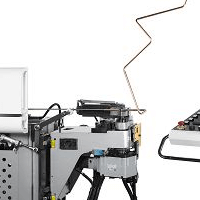In order to keep complex machinery running, it needs more than just a source of power. It also needs a way to transfer that energy from one place to another, whether that's through gasoline or through electricity.
The tubes that we see in vehicles, for example, are used to send gasoline from the tank to the engine. Other machines might use metal or plastic tubing to protect wiring.

What is tube bending?
Tube bending is a catchall phrase used to describe the process of permanently forming pipes and tubing, such as the kinds you find in your home or car. These tubes are usually made from a metal, such as an alloy, aluminum, steel, or titanium, but plastic tube forming is also necessary for some applications.
Tube bending machinery
The first step in using tube bending machinery involves clamping the tube between two tube bending dies; this can be the clamping block and forming die, and the tube may also be held by a wiper die and pressure die also. From there, the pipes are bent at a specific angle, depending on the purpose for which they will be used.
Many tube bending machines are often CNC machines, which stands for computer numerical control. These types of machines are used for large-scale production jobs, usually in factories, and they can store the settings of each project.
While some tube bending can be done manually, the CNC process eliminates the room for human error, so tubes are bent at the precise angle required for a machine. In order to prevent a pipe or tube from collapsing, a mandrel is placed inside of it to retain its shape.
Tube bending for larger part applications
Additionally, some tube bending machinery requires the use of extreme heat in order to form metal tubing. The heat induction process requires an induction coil to be placed around the pipe at its bend point. It is then heated anywhere between 800 and 2,200 °F (430 and 1,200 °C), and then pressure is applied to bend the pipe.
This type of tube bending is used for larger applications, such as in power plants or for petroleum pipelines. Hot slab or sand packing forming can heat the tube in a furnace to 1,600 °F (870 °C) or hotter before the pipe is formed and bent.
Because a tube bending process must be 100% precise, those operating it must use the most accurate tube bending calculations to determine the size and angles of a tube. Tube bending machinery is generally fairly complex equipment, only operated by manufacturing experts.
Have questions about pipe and tube bending?
Feel free to leave a comment below and contact us about the tube bending machines your company requires.